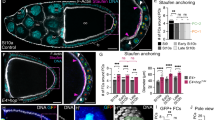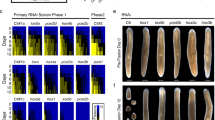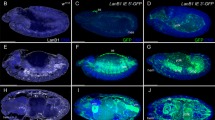Abstract
Segmentation in the insect embryo is initiated by maternally provided information, which is stored in the developing oocyte1–6. In Drosophila, the genes necessary for this process have been genetically characterized2–6. The anterior segmented region is organized by the bicoid (bcd) gene product2. The posterior segmented region is organized by several interacting gene products, among them the oskar (osk)3–5 gene product. The first zygotic group of genes, which are thought to respond to the spatial cues provided by the maternal genes, are the gap genes7–9, whose members include hunchback (hb), Krüppel (Kr) and knirps (kni)7. To elucidate the role played by the maternal genes in expression of the gap gene hb, antibodies were raised against a fusion protein and were used for the cytological localization of the hb gene product in wild-type and mutant embryos. The hb protein is pre-dominantly located in the nucleus. Its spatial expression includes the formation of an anterior-posterior gradient during the early cleavage stages and a strong zygotic expression in the anterior half of the embryo. Analysis of embryos mutant for the maternal genes affecting the anterior-posterior segmentation pattern shows that the formation of the early gradient is controlled by the osk group of genes, whereas efficient activation of the zygotic anterior expression domain is dependent on bcd activity.
This is a preview of subscription content, access via your institution
Access options
Subscribe to this journal
Receive 51 print issues and online access
$199.00 per year
only $3.90 per issue
Buy this article
- Purchase on Springer Link
- Instant access to full article PDF
Prices may be subject to local taxes which are calculated during checkout
Similar content being viewed by others
References
Sander, K. Adv. insect Physiol 12, 125–238 (1976).
Frohnhöfer, H. G. & Nüsslein-Volhard, C. Nature 324, 120–125 (1986).
Schüpbach, T. & Wieschaus, E. Wilhelm Roux Arch. dev. Biol. 195, 302–317 (1986).
Lehmann, R. & Nüsslein-Volhard, C. Cell 47, 141–152 (1986).
Lehmann, R. & Nüsslein-Volhard, C. Nature 329, 167–170 (1987).
Nüsslein-Volhard, C., Frohnhöfer, H.-G. & Lehmann, R. Science 238, 1675–1681 (1987).
Nüsslein-Volhard, C. & Wieschaus, E. Nature 287, 795–801 (1980).
Meinhardt, H. J. Cell. Sci. suppl. 4, 357–381 (1986).
Jäckle, H., Tautz, D., Schuh, R., Seifert, E. & Lehmann, R. Nature 324, 668–670 (1986).
Lehmann, R. & Nüsslein-Volhard, C. Devl. Biol 119, 402–417 (1987).
Tautz, D. et al. Nature 327, 383–389 (1987).
Bender, M., Turner, F. R. & Kaufmann, T. Devl Biol 119, 418–432 (1987).
Foe, V. E. & Alberts, B. M. J. Cell Sci. 61, 31–70 (1983).
Frohnhöfer, H. G. & Nüsslein-Volhard, C. Genes & Dev. 1, 880–890 (1987).
Macdonald, P. & Struhl, G. Nature 324, 537–545 (1986).
Mlodzik, M. & Gehring, W. J. Cell 48, 465–478 (1987).
Gaul, U., Seifert, E. Schuh, R. & Jäckle, H. Cell 50, 639–647 (1987).
Rüther, U. & Müller-Hill, B. EMBO J. 2, 1791–1794 (1983).
Author information
Authors and Affiliations
Rights and permissions
About this article
Cite this article
Tautz, D. Regulation of the Drosophila segmentation gene hunchback by two maternal morphogenetic centres. Nature 332, 281–284 (1988). https://doi.org/10.1038/332281a0
Received:
Accepted:
Issue Date:
DOI: https://doi.org/10.1038/332281a0
Comments
By submitting a comment you agree to abide by our Terms and Community Guidelines. If you find something abusive or that does not comply with our terms or guidelines please flag it as inappropriate.



